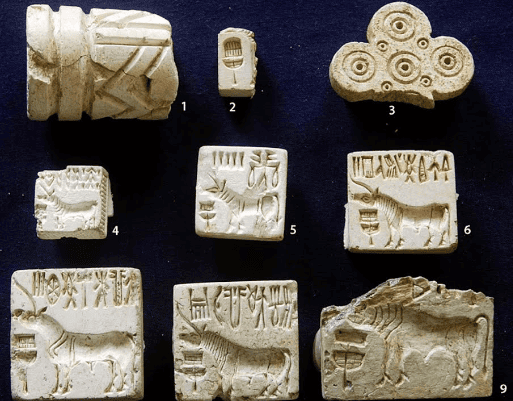Seals of Harappan Civilization: Seals and Sealings | History Optional for UPSC (Notes) PDF Download
Seal Making in the Harappan Civilization
Seal making was a significant craft in the Harappan civilization, reflecting their advanced skills and artistry. The seals, which served various purposes, were primarily made from materials like steatite, with some crafted from silver, faience, and calcite.
Types and Materials of Seals
- Shapes: Most seals are square or rectangular in shape, although a few cylindrical and round seals have also been discovered.
- Materials: The majority of seals are made of steatite, a soft stone that was easy to carve. However, there are also seals made of silver, faience (a glazed ceramic material), and calcite.
Inscription
- Many seals feature short inscriptions, which may have been used for identification, trade, or other purposes.

Significance in the Reconstruction of Religious Life of the Harappan People
The sealings featuring narrative scenes likely served a religious or ritualistic purpose.
- One particular seal depicts a nude woman in an unusual position, with a plant emerging from her body. This image is often interpreted as an early representation of Shakambari, the Earth Mother.
- The Harappans also worshipped a male deity, commonly known as the Pashupati seal, based on a steatite seal found in Mohenjodaro.
- This male figure is depicted with a buffalo horn headdress, seated on a dais with his legs bent beneath him. He is surrounded by four animals: an elephant, a rhinoceros, a water buffalo, and a tiger. Beneath the dais are two antelopes or ibexes.
- The resemblance between this figure and Shiva from later Hindu mythology is noteworthy.
The seals and sealings from the Harappan civilization showcase various trees, plants, and animals, some of which may have held cultic significance.
- The Pipal tree, for instance, appears frequently and may have been an object of veneration.
- Animals such as the humped and humpless bull, snake, elephant, rhinoceros, antelope, gharial, and tiger could have had religious importance.
- The composite animals depicted on seals, like the tiger-human and bull-elephant combinations, as well as the “unicorn,” might also carry religious or mythological meanings.
Significance of Seals in Understanding Harappan Society
- Human Sacrifice Representation: A cylinder seal from Kalibangan depicts a woman surrounded by two men, one holding her and the other raising a sword, possibly indicating the practice of human sacrifice.
- Writing on Seals: Most inscriptions appear on seals and sealings, potentially reflecting the language of the ruling elite. These inscriptions are typically short, averaging around five signs.
- Information on Attire: Seals offer insights into the clothing, ornaments, and hairstyles of Harappan people.
- Artistic Skill: Seals demonstrate the artistic and sculptural skills of Harappan craftsmen.
- Trade and Transportation: Depictions of river and seafaring boats on seals suggest their use in both internal and external trade.
- External Trade Networks: The discovery of Harappan seals in regions like Central Asia, the Persian Gulf, and Mesopotamia aids in reconstructing the Harappan external trade networks.
- Silver Seal in Turkmenistan: A rectangular Harappan seal with inscriptions was found in southern Turkmenistan, indicating the spread of Harappan culture.
- Seals in Iran: Sites in Iran have also yielded seals, further linking the Harappans to these regions.
- Seals in the Persian Gulf: Round seals with motifs like the short-horned bull and Harappan writing were discovered in the Persian Gulf, showcasing Harappan influence.
- Seals in Bahrain and Mesopotamia: Seals with Harappan motifs and writings were found in Bahrain and at Mesopotamian sites, indicating trade and cultural exchanges.
Merchant Activities
Some writings on sealings, impressed onto clay tablets, likely served to authenticate merchants' bales of merchandise. Impressions of textiles on these sealings support this theory.- Tokens and Amulets: Some seals may have functioned as tokens in trade, while others could have been worn as amulets or used as identification markers by affluent individuals like landowners, merchants, priests, artisans, and rulers.
- Ruling Elites: Seals bearing names, titles, and symbols of the ruling elite could provide valuable insights into Harappan rulers if the inscriptions were deciphered.
- Clan Symbols: Kenoyer suggests that animals depicted on square stamp seals represent totemic symbols of specific clans, with at least ten clans identified by animals like the unicorn, humped bull, elephant, and others.
- Unicorn Seal Significance: Ratnagar argues that the prevalence of unicorn seals in major cities indicates its significance as a symbol of the Harappan ruling elite. Kenoyer, however, believes that the unicorn clan symbolized the aristocracy or influential merchants, while less common motifs like the bull and tiger represented the most powerful rulers.
- Reconstruction of Life: Seals and sealings are vital for reconstructing the socio-economic and religious life of the Harappan people when combined with other literary and archaeological evidence.
|
71 videos|819 docs
|
FAQs on Seals of Harappan Civilization: Seals and Sealings - History Optional for UPSC (Notes)
| 1. What is the significance of seals in the Harappan Civilization? |  |
| 2. How do seals contribute to our understanding of the religious life of the Harappan people? |  |
| 3. What role did seals play in merchant activities during the Harappan Civilization? |  |
| 4. How do sealings help in understanding the administrative practices of the Harappan Civilization? |  |
| 5. What are the common motifs found on Harappan seals, and what do they signify? |  |

|
Explore Courses for UPSC exam
|

|
















